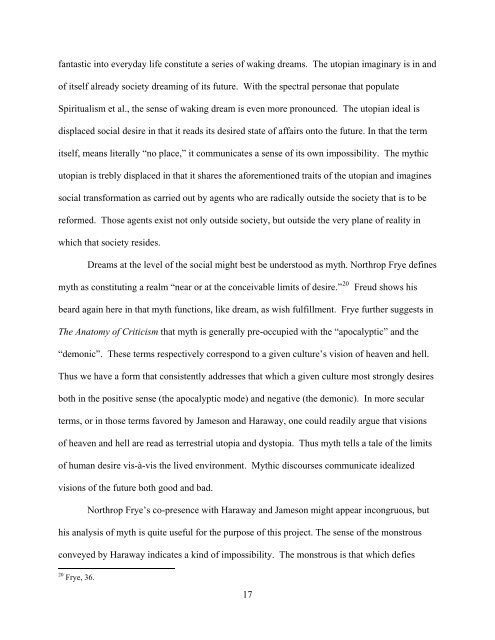A Genealogy of the Extraterrestrial in American Culture
A Genealogy of the Extraterrestrial in American Culture
A Genealogy of the Extraterrestrial in American Culture
You also want an ePaper? Increase the reach of your titles
YUMPU automatically turns print PDFs into web optimized ePapers that Google loves.
fantastic <strong>in</strong>to everyday life constitute a series <strong>of</strong> wak<strong>in</strong>g dreams. The utopian imag<strong>in</strong>ary is <strong>in</strong> and<br />
<strong>of</strong> itself already society dream<strong>in</strong>g <strong>of</strong> its future. With <strong>the</strong> spectral personae that populate<br />
Spiritualism et al., <strong>the</strong> sense <strong>of</strong> wak<strong>in</strong>g dream is even more pronounced. The utopian ideal is<br />
displaced social desire <strong>in</strong> that it reads its desired state <strong>of</strong> affairs onto <strong>the</strong> future. In that <strong>the</strong> term<br />
itself, means literally “no place,” it communicates a sense <strong>of</strong> its own impossibility. The mythic<br />
utopian is trebly displaced <strong>in</strong> that it shares <strong>the</strong> aforementioned traits <strong>of</strong> <strong>the</strong> utopian and imag<strong>in</strong>es<br />
social transformation as carried out by agents who are radically outside <strong>the</strong> society that is to be<br />
reformed. Those agents exist not only outside society, but outside <strong>the</strong> very plane <strong>of</strong> reality <strong>in</strong><br />
which that society resides.<br />
Dreams at <strong>the</strong> level <strong>of</strong> <strong>the</strong> social might best be understood as myth. Northrop Frye def<strong>in</strong>es<br />
myth as constitut<strong>in</strong>g a realm “near or at <strong>the</strong> conceivable limits <strong>of</strong> desire.” 20<br />
Freud shows his<br />
beard aga<strong>in</strong> here <strong>in</strong> that myth functions, like dream, as wish fulfillment. Frye fur<strong>the</strong>r suggests <strong>in</strong><br />
The Anatomy <strong>of</strong> Criticism that myth is generally pre-occupied with <strong>the</strong> “apocalyptic” and <strong>the</strong><br />
“demonic”. These terms respectively correspond to a given culture’s vision <strong>of</strong> heaven and hell.<br />
Thus we have a form that consistently addresses that which a given culture most strongly desires<br />
both <strong>in</strong> <strong>the</strong> positive sense (<strong>the</strong> apocalyptic mode) and negative (<strong>the</strong> demonic). In more secular<br />
terms, or <strong>in</strong> those terms favored by Jameson and Haraway, one could readily argue that visions<br />
<strong>of</strong> heaven and hell are read as terrestrial utopia and dystopia. Thus myth tells a tale <strong>of</strong> <strong>the</strong> limits<br />
<strong>of</strong> human desire vis-à-vis <strong>the</strong> lived environment. Mythic discourses communicate idealized<br />
visions <strong>of</strong> <strong>the</strong> future both good and bad.<br />
Northrop Frye’s co-presence with Haraway and Jameson might appear <strong>in</strong>congruous, but<br />
his analysis <strong>of</strong> myth is quite useful for <strong>the</strong> purpose <strong>of</strong> this project. The sense <strong>of</strong> <strong>the</strong> monstrous<br />
conveyed by Haraway <strong>in</strong>dicates a k<strong>in</strong>d <strong>of</strong> impossibility. The monstrous is that which defies<br />
20 Frye, 36.<br />
17















